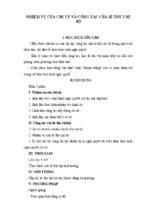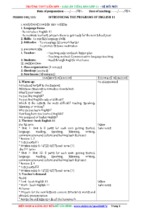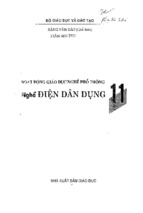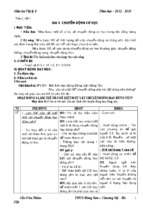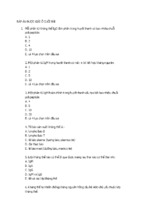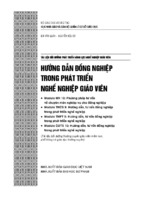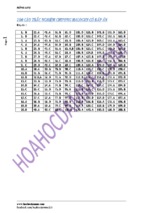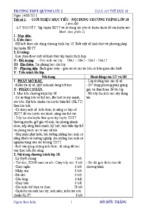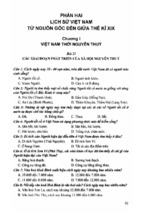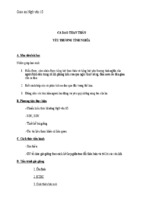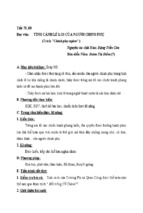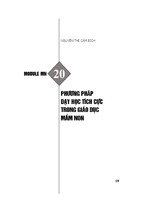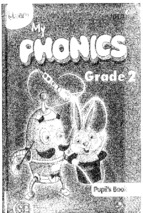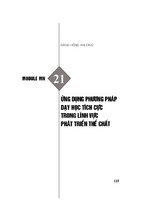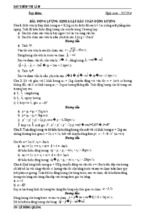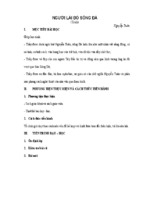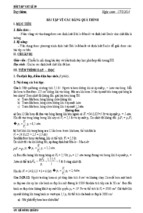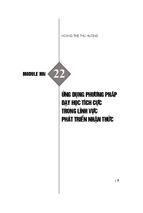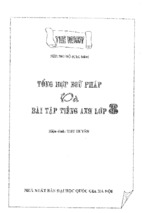_______Bộ GIÁO DỤC VÀ ĐÀO TẠO__
HOÀNG VĂN VÂN (Tổng chủ biên) - LƯƠNG QUỲNH TRANG (Chủ biên)
NGUYỄN THỊ CHI - LÊ KIM DUNG - PHAN CHÍ NGHĨA - NGUYỀN THỤY PHƯƠNG
LAN p Vũ MAI TRANG
Với sự cộng tác của DAVID KAYE
Page
INTRODUCTION..............................................................................-........................................................111
BOOK MAP ..............................................................................................................................................................4
UNBT Is LOCAL ENVIRONMENT
..
~6
UNIT 2: CITY LIFE .
......................................................................................................................................16
26
UNIT 3: TEEN STRESS AND PRESSURE
REVIEW 1
___________________________________________________________________________
______________________—.....................................36
UNIT 4: LIFE IN THE PAST
40
UNIT 5: WONDERS OF VIET NAM
50
UNIT 6: VIET NAM: THEN AND NOW
60
REVIEW 2 ...............................................-....................................................................—
.............70
GLOSSARY....................................................................................................-.................-.....74
TIÉNG ANH 9 is the final of the four levels of English language textbooks for Vietnamese
students in lower secondary schools learning English as a foreign language (EFL). It follows
the systematic, cyclical, and theme-based syllabus approved by the Ministry of Education and
Training in January 2012, which focuses on the use of language (pronunciation, vocabulary,
and grammar) to develop the four language skills (listening, speaking, reading, and writing).
THE COMPONENTS OF THE TEXTBOOK
The complete learning set of TSENG ANH 9 consists of THE STUDENT'S BOOK, THE
TEACHER'S BOOK, THE WORKBOOK, and THE CdJ
THE STUDENT'S BOỠSC The Student's Book contains:
Book map: Introducing the basics of each unit
12 topic-based Units, each covering seven sections to be taught in seven 45-minute lessons
Four Reviews, each providing revision and further practice of the previous three units, to be
dealt with in two periods
Glossary: Giving meaning and phonetic transcription of the new words in the units THE
TEACHER'S BOOK
The Teacher's Book gives full procedural notes for teaching different parts of each unit. The
answer keys to the exercises in the Student's Book and the transcriptions are also given in the
Teacher's Book.
THE WORKBOOK
The Workbook mirrors and reinforces the content of the Student's Book. It offers:
Further practice of the language and skills taught in class Four additional tests for students'
self-assessment
THE CO
The CD provides recorded scripts of all listening exercises and dialogues
THE COMPONENTS OF EACH UNIT
There are 12 main units in the Student's Book. Each unit has seven sections and provides
language input for seven classroom lessons of 45 minutes each.These 12 richly illustrated,
cross-curricular, and theme-based units focus on offering students motivation, memorable
lessons, and a joyful learning experience. At the beginning of each unit there are explicit
learning objectives that clearly state the main language and skills to be taught in the unit.
SECTION 1: GETTING STARTED
This section occupies two pages and is designed for one 45-minute lesson in class. It begins
with a conversation followed by activities which introduce the topic of the unit. It then
presents the vocabulary and the grammar items to be learnt and practised through the skills
and activities of the unit.
SECTION 2: A CLOSER LOOK 1
A Closer Look 1 and A Closer Look 2 are each designed to be taught in one 45-minute lesson.
INTRODUCTION III
A Closer Look 1 presents and practises the vocabulary and pronunciation of the unit The
active vocabulary of the unit is given in an interesting and illustrated way so that it is easy for
students to memorise. Two or three sounds, which frequently appear in the unit, are targeted
and practised in isolation and in context. There are different exercises focusing on intensive
practice of vocabulary and pronunciation.
A grammar item may also be included in this section.
SECTION 3: A CLOSER LOOK 2
This section deals with the main grammar point(s) of the unit. The new language points are
presented in a short text or a talk/interview. There are grammar tables and exercises which are
well illustrated to help students remember and use the grammar items effectively. The
‘Remember’ boxes appear wherever necessary and help students to avoid common errors.
A Closer Look 1 and /I Closer Look 2 cover three pages and mainly give language focus and
practice of receptive skills.
SECTION 4: COMMUNICATION
This section is designed to help students use the functional language in everyday life contexts
and to consolidate what they have learnt in the previous sections. It also gives students
opportunities to learn and apply the cultural aspects of the language learnt. The
communication section provides cultural information about Viet Nam and other countries in
the world. The vocabulary is clearly presented in boxes wherever it is needed.
SECTION 5: SKILLS 1
Skills 1 and Skills 2, each covers one page and is designed to be taught in one 45-minute
lesson. Skills 1 comprises reading (receptive skill) and speaking (productive skill).
H@€sdBBag
This section aims to develop students' reading abilities. In order tó make the activity
achievable, the reading text is often based on the vocabulary and structures that students have
previously acquired. The reading always links with the topic of the unit and is interesting and
relevant to the students. Important new vocabulary is introduced in the text and practised in a
follow-up activity.
The reading also provides input for the speaking that follows.
Speaking
This section aims to provide further practice which supports students in their production of
spoken English.The section uses the recently introduced items in combination with previously
learnt language in new contexts.
SECTION 6: SKILLS 2
Skills 2 is composed of listening (receptive skill) and writing (productive skill).
Listening
The listening section provides students with an opportunity to develop their listening skills.
This section trains them to listen for general and specific information.
Writing
This section focuses on developing students'writing skills. There is a writing tip or a guideline
which is very useful to help them to write effectively. The result of the writing section must
be a complete piece of writing (which is ideally assessed by the group/class/teacher).
SECTION 7: LOOKING BACK & PROJECT
This section covers two pages and should be dealt with in one 45-minute lesson.
Looking Back recycles the language from the previous sections and links it with unit topics.
Various activities and exercises are designed to help students consolidate and apply what they
have learnt in the unit. Through the students' performance in this section, teachers can
evaluate their study results and provide further practice if necessary.
The Project helps students to improve their ability to work by themselves and in a team. It
extends their imagination in a field related to the unit topic. The teacher can use this as an
extra-curricular activity (for groupwork) or as homework for students to do individually.
REFERENCE FOR SKILLS AND LANGUAGE TEACHING
1. TEACHING READING
Reading is the first of the four language skills that receives special attention in Tiếng Anh 9.
The reading activities in Tiếng Anh 9 aim to help students develop sub-skills such as
skimming for gist and scanning for details.
Explanations should be given to students when they do not understand the meaning of a word.
Some reading strategies such as focusing on familiar words, guessing unfamiliar words in
context, etc. should be taught to students.
Before teaching the text, the teacher should encourage students to guess what the text is about,
what new words may appear in the text, etc.
2. TEACHING SPEAKING
There are two forms of speaking in Tiếng Anh 9: spoken interaction and spoken production.
The first refers to the ability to ask and answer questions and handle exchanges with
others.The second refers to students'ability to produce language appropriately and correctly.
Speaking activities include:
Pronunciation: dialogues and role-plays (games, rhymes, and songs). Through these forms,
students practise the stress, rhythm, and intonation patterns of English in a natural way. It is
crucial to provide students with a lot of models and to build up their confidence with
acceptance of approximate correct pronunciation.
Repetition: helps students to memorise vocabulary and ‘chunks’ language. Repetition and
classroom routines build up an expanding repertoire of English that helps students understand
and respond to a situation as a part of communicative interactions in class. One strategy is to
provide a lot of opportunities for students to practise with a secure feeling through choral
repetition of action rhymes and games. It is also important to establish classroom routines
(such as greetings and saying goodbye) at the beginning and the end of the lessons. Asking
for permission, using common classroom expressions (e.g. I don't understand. Could you say
it again, please? May I ask you a question?), or answering a question (e.g. I don't know. I
think/guess..., Perhaps...) are important language tasks for students to practise daily.
Pair work/group work and class presentations help students to talk freely in a language
situation related to the topic of the unit. They also make students feel secure and promote their
confidence in speaking.
Error correction should be done cautiously by the teacher. When students are talking, the
teacher should not stop them to correct their mistakes. Mistakes should be analysed and only
common errors should be highlighted afterwards and corrected collectively.
3. TEACHING LISTENING
Through listening, students become familiar with the sounds, rhythms, and intonation of
English. When listening to English, students are actively engaged in constructing meaning
and making sense of what they hear, using their knowledge and the clues provided by the
context. It is very important to teach students to be aware of the purpose, the content, and
intonation of the listening text.
INTRODUCTION V
Before listening, teachers should motivate and engage students in the listening activity;
encourage them to predict the listening content; and introduce the new language or vocabulary
which occurs in the listening text.
The listening activities aim to help students understand spoken English and develop sublistening skills such as listening for gist and listening for details.
4. TEACHING WRITING
The writing activities aim to develop students'basic writing skills in English. Its emphasis is
on providing writing techniques for a particular genre (e.g. email, an informal letter, a
webpage, etc.) as well as practising the spelling of familiar vocabulary and sentence patterns.
Teaching writing can be divided into three stages: before writing, while writing, and after
writing.
Before writing helps students understand why they write and provides them with the language
input to express their ideas in English.
While writing helps students write independently under the teacher's guidance and
supervision.
After writing helps students perfect their writing. They share their writing with peers and
teacher for comments. After that, they revise (i.e. re-reading the writing to improve the
content and organisation of ideas) and edit (i.e. re-reading the writing to correct errors and
mistakes in grammar, vocabulary, spelling, etc.) it. They then submit their writing to the
teacher for evaluation.
5. TEACHING PRONUNCIATION
In this book, the pronunciation part focuses on sentence stress and intonation. The students
will have chance to practise saying sentences with correct stress on content words. Also, they
can identify in which situations to stress pronouns, the verb ‘be’, auxiliaries, and short words
and say these sentences correctly. Besides, they will practise intonation patterns in English.
In teaching sentence stress and intonation, it is advisable that the teacher should engage the
students by using varied techniques including:
Visual aids (flashcards, pictures, etc.)
Miming
Syllable/word focus and repetition Line by line repetition and clapping Listening and marking
the stressed words Pair/group practice and performance
6. TEACHING VOCABULARY
Teaching vocabulary helps students understand, memorise, and use words appropriately in
their specific contexts. Students at lower secondary level still learn ‘chunks’ of English which
combine vocabulary and grammatical patterns in an unanalysed way.Therefore, it is crucial to
give students plenty of time to practise, memorise, recycle, and extend their vocabulary and
grammar in meaningful contexts. Regular recycling of vocabulary helps students recognise
the same words embedded in different contexts and activities again and again. When teaching
vocabulary, it is important to help students recognise, practise, and memorise words. This can
be done by using visual aids (e.g. pictures, flashcards), by allowing students to listen and
repeat the words, by explaining their meanings, using definitions and translation if necessary,
and finally, by getting students to practise using the words with a range of spoken or written
activities, which can be done individually or in pairs.
n
VI
11 RODUCTiQN
Writing an email to give information about places of interest in an area and things to do there
- Complex sentences (adverb clauses of result, reasons, concession): review
- Phrasal verbs
- Pronunciation: Stress on content words in sentences
Arranging a visit to a place of interest in the region
Giving a
presentation
about
something
special in an
area
Writing a paragraph about disadvantages/ drawbacks of city life
- Comparison of adjectives and adverbs: review
I Phrasal verbs (continue)
- Pronunciation: Stress on pronouns in sentences
Discussing some features of a city
Writing notices
Writing a short note to ask for advice and to give advice
Reported speech: review
Question words before fo-infinitive
Pronunciation: Stress on the verb be in sentences
Discussing necessary life skills for teens
Giving a presentation about a support group in the school
Writing a description of how children in the past studied without technology
I Used to: review
- Wishes for the present
I Pronunciation: Stress on auxiliary verbs in sentences
Describing past practices
Making a poster on the preservation of a past tradition or pastime
Writing an article describing a wonder of Viet Nam
Passive voice: Impersonal passsive
suggest + verb-ing/suggest (that) + subject + should
Pronunciation: Stress on short words (a, of, or) in sentences
Describing a wonder of Viet Nam
Making a promotional brochure about a wonder of Viet Nam
Writing about some qualities a person needs to get along in an extended family
- Past perfect: review
-
Adjective + fo-infinitive; Adjective + f/?af-ciause
~ Pronunciation: Stress on all the words in sentences
Talking about.some changes in Viet Nam
Making a photo exhibition about school life in Viet Nam then and now
BOOK MAP
7. TEACHING GRAMMAR
Teaching grammar helps students use correct grammatical patterns to express their ideas in
specific contexts.
Grade 9 students of English already know some English grammar based pn formulaic
sequences and a lot of grammar points met in the context of dialogues, readings, chants,
rhymes, stories, and songs they have learnt in primary schools, grade 6, grade 7, and grade 8.
One way to raise students' language awareness is drawing their attention to specific language
patterns or features of grammatical forms and, if necessary, comparing or contrasting these
with corresponding patterns and forms in Vietnamese. The appropriate techniques to be used
to teach students are:
Focusing students'attention on the new grammatical patterns in the texts.
Providing models for students to practise the new grammatical item in a spoken or written
activity, using the cued pictures or prompts in their books.
Reinforcing the new grammatical item with a variety of spoken and written activities.
SEQUENCING §j
Students should be given clear instructions about what they are expected to do and say. The
following are some suggested teaching procedures.
Whole class. Elicit/Teach the focus language (words, phrases, or structures). Then write them
on the board.
Model. Perform the focused materials yourself with a confident student or ask a pair to
demonstrate in front of the class. Help and guide them to interact in a reasonably structured
manner. This will enable the freer stage of independent pair work/group work that will follow.
Pairs/groups. Students practise in pairs or groups. Monitor the activity and offer help if
necessary.
Performance. Ask a confident pair or some volunteers to perform the task for the rest of the
class.
Whole class. At the end of the activity, there should be some writing/speaking (productive)
activities to reinforce or consolidate students' understanding.
It is noted that all of the procedures written in this book are only suggestions. Teachers may
adapt these or design their own procedures to suit their students and real teaching contexts.
Before listening, teachers should motivate and engage students in the listening activity;
encourage them to predict the listening content; and introduce the new language or vocabulary
which occurs in the listening text.
The listening activities aim to help students understand spoken English and develop sublistening skills such as listening for gist and listening for details.
4. TEACHING WRITING
The writing activities aim to develop students' basic writing skills in English. Its emphasis is
on providing writing techniques for a particular genre (e.g. email, an informal letter, a
webpage, etc.) as well as practising the spelling of familiar vocabulary and sentence patterns.
Teaching writing can be divided into three stages: before writing, while writing, and after
writing.
Before writing helps students understand why they write and provides them with the language
input to express their ideas in English.
While writing helps students write independently under the teacher's guidance and
supervision.
After writing helps students perfect their writing. They share their writing with peers and
teacher for comments. After that, they revise (i.e. re-reading the writing to improve the
content and organisation of ideas) and edit (i.e. re-reading the writing to correct errors and
mistakes in grammar, vocabulary, spelling, etc.) it. They then submit their writing to the
teacher for evaluation.
5. TEACHING PRONUNCIATION
In this book, the pronunciation part focuses on sentence stress and intonation.The students
will have chance to practise saying sentences with correct stress on content words. Also, they
can identify in which situations to stress pronouns, the verb ‘be’( auxiliaries, and short words
and say these sentences correctly. Besides, they will practise intonation patterns in English.
In teaching sentence stress and intonation, it is advisable that the teacher should engage the
students by using varied techniques including:
Visual aids (flashcards, pictures, etc.)
Miming
Syllable/word focus and repetition Line by line repetition and clapping Listening and marking
the stressed words Pair/group practice and performance
6. TEACHING VOCABULARY
Teaching vocabulary helps students understand, memorise, and use words appropriately in
their specific contexts. Students at lower secondary level still learn ‘chunks’ of English which
combine vocabulary and grammatical patterns in an unanalysed way. Therefore, it is crucial to
give students plenty of time to practise, memorise, recycle, and extend their vocabulary and
grammar in meaningful contexts. Regular recycling of vocabulary helps students recognise
the same words embedded in different contexts and activities again and again. When teaching
vocabulary, it is important to help students recognise, practise, and memorise words. This can
be done by using visual aids (e.g. pictures, flashcards), by allowing students to listen and
repeat the words, by explaining their meanings, using definitions and translation if necessary,
and finally, by getting students to practise using the words with a range of spoken or written
activities, which can be done individually or in pairs.
* I Listen and read.
Nick: There are so many pieces of pottery here,
Phong. Do your grandparents make all of them?
Phong: They can't because we have lots of products. They make some and other people make
the rest.
Nick: As
far as I know, Bat Trang is one of the most
famous traditional craft villages of Ha Noi, right?
Phong: Right. My grandmother says it's about 700 years old.
Mi: Wow/ When
did your grandparents set up
this workshop?
Phong: My great-grandparents started it, not my grandparents. Then my grandparents took
over the business. All the artisans here are my aunts, uncles, and cousins.
Mi: I see. Your village is also a place of interest of
Ha Noi, isn't it?
Phong: Yes. People come here to buy things for their house. Another attraction is they can
make pottery themselves in workshops.
Nick: That
must be a memorable experience.
Phong: In Viet Nam there are lots of craft villages like BatTrang. Have you ever been to any
others?
Mi: I've been to a conical hat making village in
Hue!
Nick: Cool! This is my first one. Do you think
that the various crafts remind people of a specific region?
Mi: Sure. It's the reason tourists often choose
handicrafts as souvenirs.
Phong: Let's go outside and look round the village.
SKILLS
• Reading for general and specific information about a traditional craft village
•
Discussing local traditional crafts, their benefits and challenges
• Listening for specific information about places of interest in an area
• Writing an email to give information about places of interest in an area and things to do
there
COMMUNICATION
Arranging a visit to a place of interest in the region
GRAMMAR
Complex sentences: review Phrasal verbs
.
I MirwiMi I iff IIMIII Iimm ■ II .jiu^wjja ii—mtmmmr JIM MIT inmrriTM
————I THIS UNỈT INCLUDES:
esnEBẼữmm D
I_ VOCABULARY
A visit to a traditional piacM°nnterPst
craft village
PRONUNCIATION
Stress on content words in sentences
mrnm n n »
6 Unit 1/ Local Environment
Objectives;
By the end of this unit, students can:
• use the lexical items related to traditional crafts and places of interest in an area
• say sentences with correct stress on content words
•
write complex sentences with different dependent clauses
• use some common phrasal verbs correctly and appropriately
• read for general and specific information about a traditional craft village
• discuss local traditional crafts, their benefits and challenges
•
listen for specific information about places of interest in an area
•
write an email to give information about places of interest in an area and things to do there
GETTING STARTED A visit to a tradstionaB craft vil
Ask Ss to open their books and look at the picture and the phrase under GETTING
STARTED. Ask them some questions:
• Who and what can you see in the picture?
• Where are they?
• What do you think the people in the picture are talking about?
Ss answer the questions as a class. If they mention ‘Bat Trang’, elicit what they know about
this village.
Play the recording and have Ss follow along. After that, Ss can compare their answers with
the information in the dialogue and add some more details to their answers.
I Ss work independently to find the words with the given meanings in the dialogue. Allow Ss
to share their answers before asking them to discuss as a class. Remember to ask Ss to read
out the lines in the dialogue that contain the words. Quickly write the correct answers on the
board.
Key:
1. craft 2. set up
5. attraction
3.
take over 4. artisans
6. specific region
7.
remind
8. look round
Have Ss look at the Watch out! box and quickly read the information.Tell them that there are
some similar expressions such as ‘as far as I can remember', ‘as far as I can see’, or ‘as far as I
can tell’.
) Have Ss read the questions to make sure they understand them. Ask them firstly to answer
the questions without reading the dialogue again. Ss exchange their answers with a classmate.
Now ask them to check their answers by reading the dialogue again. Ask for Ss' answers.
Key: 1. They are at Phong's grandparents'workshop in BatTrang.
2. It is about 700 years old.
3. His great-grandparents did.
4. Because people can buy things for their house and make pottery themselves there.
5. It's in Hue.
6. Because the handicrafts remind them of a specific region.
■ . - ----- B-I____!___i__§1
! Have Ss look at the pictures. Tell Ss that in the box are some traditional handicrafts of
different regions in Viet Nam. Ss match these handicrafts with the pictures. Ss compare their
answers in pairs before giving their answers to T.
Key:
A. paintings
E.silk
B. drums
F. lacquerware
c. marble sculptures D. pottery
G. conical hats H. lanterns
Tell Ss to complete the sentences with the words/phrases in %. The complete sentences will
give Ss information about the places where the handicrafts are made. Call on two Ss to write
their answers on the board. Confirm the correct answers.
If time allows, T may organise a short activity to check Ss' short-term memory. Have Ss close
their books. Point at each of Ss' answers on the board and quickly Ss have to call out the place
where this handicraft is made. Ss can also be asked to share any other places that produce
these handicrafts.
Key:
5. Pottery 6. marble sculptures
1. conical hat 2. lanterns 3. silk 4. paintings
a Ss work in pairs to do the quiz. The pair which has the answers the fastest is invited to read out their
answers. Elicit feedback from other pairs. Confirm the correct answers.
Key:
5. beauty spot
l.park 2. museum 3. zoo 4. beach
J.V-; -iij-m. - , 1 J
b Ss work in groups to write a similar quiz about places of interest. Set a time limit of about
five to seven minutes. When time is up, ask the first group to read out a question in their quiz.
Ss from other groups give the answer. The group confirms the correct answer. The second
group then reads out a question in their quiz. This question should be different from the one of
the first group. Continue the activity until all the groups have read out all of their questions or
when time is up.
Unit 11 Local Environment 7T
A CLOSER LOOK 1
■■—|--'n—r -TrwrormmrHnrri r«nn —
ocabulary
Ss work individually to do this exercise and then compare their answers with a classmate.
Elicit the answers from Ss and quickly write them on the board. Do not confirm the correct
answers at this stage. Have Ss explain the meaning of each verb in English or Vietnamese.
Correct Ss' explanations when needed. The two verbs cast and mould are quite difficult, so
make sure that Ss understand them:
- cast: shape
hot liquid metal, etc. by pouring it into a container
- mould: shape a soft substance into a particular form or object by pressing it or by putting it
into a mould Now have Ss look at their answers on the board and say if these are correct.
.....s-n——- I —-1-\
Key:
A. cast B. carve c. embroider D. weave E. mould F. weave G. knit ___- ________:_J
§1 The purpose of this exercise is to help Ss understand more deeply and use the verbs
correctly to talk about producing and creating crafts. Ss work in pairs to do the exercise.
Check the answers as a class. If time allows, have Ss make sentences.
Key:
1.b
2.d
3.e
4. a
5.f 6.C
_I___jj— -———- . ! _/
fe This activity will help Ss to manipulate the verbs as they are not all regular.
Have Ss do the activity, then call two Ss to write their answers on the board. Elicit feedback
from other Ss. Confirm the correct answers.
Key:
2. cast; cast 3. wove; woven
5. knitted; knitted
4. embroidered; embroidered
6. moulded; moulded
_ - --------------J
Draw Ss'attention to the Watch out! box. Ask Ss to give example sentences with the verb to
make.
Organise a competition for this activity. Ss work in groups of five or six. Set a time limit of
five minutes. T may prepare some large pieces of paper for the groups to write their answers
on. Ss write down as many places of interest in the word web as possible. The group with the
most places is the winner. The winning group presents their words/phrases. Other groups tick
the similar words/phrases they have and add more if they can. If time allows, T may ask Ss to
explain why they think the places are entertaining, cultural, educational, or historical.
Suggested answers:
Entertaining: cinema, department store, restaurant, café, theatre, opera house, club, park,
zoo... Cultural: opera house, museum, craft village, historical building, theatre, market, craft
village... Educational: library, museum, theatre...
-
Historical: building, temple, shopping district, market, beauty spot, craft village...
Ss individually do the exercise. Check their answers as a class and confirm the correct ones.
Key: 1. historical 2. attraction 3. exercise 4. traditional 5. culture 6. handicrafts
Unit 1/ Local Environment 8T
renunciation
ess on content words in sentences
on Have Ss read the five sentences and underline the words they think are stressed. Elicit
answers from Ss. Do not confirm the correct answers. Now ask Ss to read the four questions
and make sure they understand them. Ask Ss to listen to the speaker read the sentences and at
the same time check whether their answers are correct. Tell them that this is actually the first
question and other questions can be answered after listening. Ss discuss their answers to the
four questions in pairs.
I Call some Ss to give the answers and give feedback. Play the recording again for Ss to
repeat the sentences.
Audio script:
The craft village lies on the river bank.
2. This painting is embroidered.
4 Drums aren't made in my village.
5. A famous artisan carved this table beautifully.
3. What is this region famous for?
Key:
1. Sentence 1: craft, village, lies, river, bank Sentence 2: painting, embroidered Sentence 3:
what, region, famous Sentence 4: drums, aren't, made, village Sentence 5: famous, artisan,
carved, table,
beautifully
2. They are: nouns, verbs, adjectives, adverbs, w/i-question words, and negative auxiliaries.
3. Sentence 1: Sentence 2: Sentence 3: Sentence 4: Sentence 5:
the, on, the this, is is, this, for in, my a, this
They are: articles, prepositions, pronouns, and possessive adjectives.
Have Ss read the information in the box to remember the content of the lesson.
Ss do this exercise individually and compare their answers with a classmate.
li Play the recording for Ss to check their answers and practise reading the sentences. Call
some Ss to give the answers and read the sentences. Give correction if needed.
Audio script and Key:
. The Arts Museum is a popular place of interest in my city.
weekends?
! Where do you like going at
' This cinema attracts lots of youngsters. We shouldn't destroy historical buildings,
Ì. The artisans mould clay to make traditional pots.
A CLOSER LOOK 2
ommar
nplex sentences: review MW
- Xem thêm -

